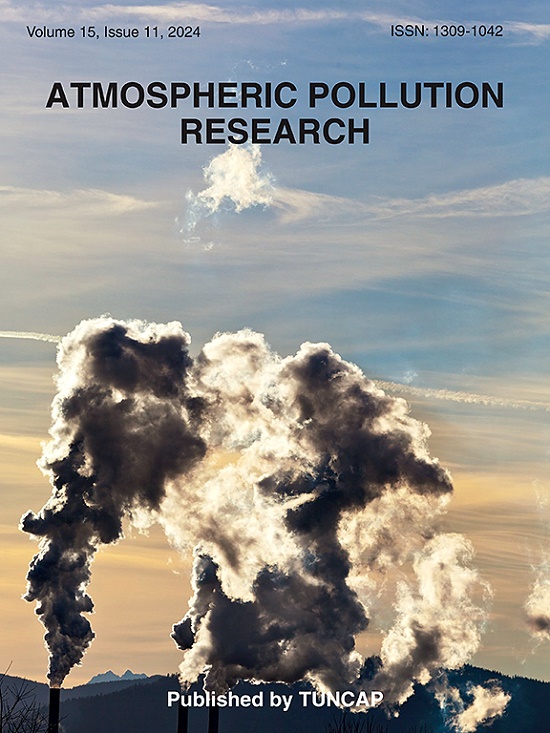混合机器学习增强WRF-Chem模型的PM2.5预测性能
IF 3.5
3区 环境科学与生态学
Q2 ENVIRONMENTAL SCIENCES
引用次数: 0
摘要
化学气象研究预报(WRF-Chem)模式在PM2.5浓度预报中得到了广泛应用。然而,全球排放清单、气象数据和简化的化学参数化的不确定性继续构成挑战。我们评估了原始WRF-Chem模型和三种增强了机器学习(ML)算法的模型的性能,即长短期记忆(LSTM),极限梯度增强(XGBoost)和XGBoost-LSTM(混合)方法,以提高预测精度。使用2019-2020年泰国南部四个监测站的wrf - chem模拟气象和污染物数据集对ML模型进行了训练和测试。WRF-Chem- hybrid模型显著改善了原始WRF-Chem结果中的所有指标,R2从不显著增加到0.90以上,RMSE从7.00-15.17 μg/m3下降到1.34-3.47 μg/m3, MAE从5.52-10.55 μg/m3下降到0.79-1.49 μg/m3。2021年全年验证试验效果良好,R2 = 0.94-0.96, RMSE = 1.56-2.48 μg/m3, MAE = 1.01-1.56 μg/m3。WRF-Chem-Hybrid模型预测PM2.5浓度提前72 h, R2 = 0.70 ~ 0.89, RMSE = 4.64 ~ 11.99 μg/m3, MAE = 3.07 ~ 8.38 μg/m3。因此,混合模式被建议用于预测泰国南部和其他地区的PM2.5浓度提前72小时。总体而言,本研究证明了增强WRF-Chem模型以形成混合ML模型的优势,以更准确地预测PM2.5水平及其随时间的分布和演变,特别是在PM2.5水平受到本地和跨境排放的开放式生物质燃烧影响的地区。本文章由计算机程序翻译,如有差异,请以英文原文为准。

Hybrid machine learning to enhance PM2.5 forecasting performance by the WRF-Chem model
The weather research and forecasting with chemistry (WRF-Chem) model had been widely used in PM2.5 concentration forecasting. However, uncertainties in global emission inventories, meteorological data, and simplified chemical parameterizations continue to pose challenges. We evaluated the performance of the original WRF-Chem model and three models augmented with machine learning (ML) algorithms, i.e. Long Short-Term Memory (LSTM), Extreme Gradient Boosting (XGBoost) and XGBoost-LSTM (Hybrid) approaches, to enhance forecasting accuracy. The ML models were trained and tested using dataset from WRF-Chem-simulated meteorological and pollutant data at four monitoring stations in southern Thailand during the year 2019–2020. The WRF-Chem-Hybrid model significantly improved all metrics in the original WRF-Chem results - with R2 increasing from insignificant to 0.90 or more, RMSE decreasing from 7.00-15.17 μg/m3 to 1.34–3.47 μg/m3, and MAE decreasing from 5.52-10.55 μg/m3 to 0.79–1.49 μg/m3. The validation test during the entire 2021 performed well, with R2 = 0.94–0.96, RMSE = 1.56–2.48 μg/m3 and MAE = 1.01–1.56 μg/m3. The WRF-Chem-Hybrid model forecast PM2.5 concentrations for 72 h in advance, with R2 = 0.70–0.89, RMSE = 4.64–11.99 μg/m3, and MAE = 3.07–8.38 μg/m3. Thus, the hybrid model is suggested for forecasting PM2.5 concentrations over southern Thailand and other regions up to 72 h in advance. Overall, this study demonstrated the advantages of augmenting the WRF-Chem model to form hybrid ML models to more accurately forecast PM2.5 levels, their distribution and evolution over time, particularly in regions where PM2.5 levels were affected by open biomass burning from both local and cross-border emissions.
求助全文
通过发布文献求助,成功后即可免费获取论文全文。
去求助
来源期刊

Atmospheric Pollution Research
ENVIRONMENTAL SCIENCES-
CiteScore
8.30
自引率
6.70%
发文量
256
审稿时长
36 days
期刊介绍:
Atmospheric Pollution Research (APR) is an international journal designed for the publication of articles on air pollution. Papers should present novel experimental results, theory and modeling of air pollution on local, regional, or global scales. Areas covered are research on inorganic, organic, and persistent organic air pollutants, air quality monitoring, air quality management, atmospheric dispersion and transport, air-surface (soil, water, and vegetation) exchange of pollutants, dry and wet deposition, indoor air quality, exposure assessment, health effects, satellite measurements, natural emissions, atmospheric chemistry, greenhouse gases, and effects on climate change.
 求助内容:
求助内容: 应助结果提醒方式:
应助结果提醒方式:


